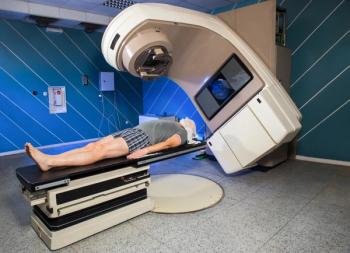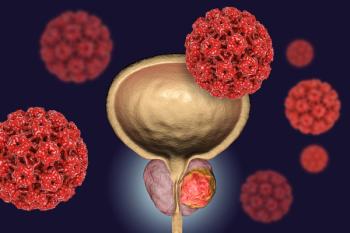
Results from this study suggest that this combination is active and should be considered for this patient population, though additional research is still necessary.

Your AI-Trained Oncology Knowledge Connection!


Results from this study suggest that this combination is active and should be considered for this patient population, though additional research is still necessary.

A recent study found that automated analyses of CT scans for patients with breast cancer can predict which patients are likely to develop cardiovascular disease in the future.

This study suggested that there is evidence, though low quality, that rituximab (Rituxan) may be a more effective second-line therapy than splenectomy for children with immune thrombocytopenia.

For adult patients with relapsed or refractory T-cell acute lymphoblastic leukemia/T-cell lymphoblastic lymphoma, a phase 1 clinical trial revealed that crenigacestat (LY3039478) demonstrated little clinical activity at the recommended dose.

AstraZeneca and Merck announced that the combination treatment of olaparib with bevacizumab to treat adult patients with advanced high-grade epithelial ovarian, fallopian tube or primary peritoneal cancer was approved in the European Union.

Patients with immune thrombocytopenia treated with rituximab (Rituxan), splenectomy, eltrombopag (Promacta), or romiplostim (Nplate) saw significant increases in platelet count with each of the 4 treatments.

A study presented at the 12th European Breast Cancer Conference suggests women over the age of 70 with breast cancer can tolerate surgery even though they aren’t offered it regularly, but a second abstract suggests these women tend to opt out of this treatment option.

The results for the phase 2 SUMMIT trial examining neratinib to treat patients of metastatic non-small cell lung cancer (NSCLC) were recently announced by Puma Biotechnology.

The study suggested that voriconazole (Vfend) may be the best prophylaxis option for patients undergoing HSCT, and posaconazole (Noxafil) may be the best prophylaxis option for patients with AML or MDS.

In a mock tumor board on prostate cancer on Twitter, health care providers came together to discuss real patient cases and present various treatment options for review.

In working patients with head and neck cancer receiving radiotherapy, weight loss and an increase in pain, fatigue, and ECOG status were all found to be significantly associated with reductions in working days per week.

This study suggested that the racial composition of clinical trials involving radiation therapy does not match that of the overall US population.

A study presented at the ASTRO Annual Meeting found that adding the advanced PET radiotracer fluciclovine (Axumin) to conventional imaging for patients with recurrent prostate cancer may improve disease-free survival rates.

“Sexual dysfunction is an unfortunately common side effect of cancer treatment, and there appears to be a large gender disparity in how physicians discuss sexual health with their patients,” said lead study author James Taylor, MD, MPH.

Researchers found there has been a 17% growth in radiation therapy facilities over the last 15 years, with expansion specifically improving for those who already live near such facilities.

The leukemia expert spoke about the importance of genetic testing for patients with acute myeloid leukemia and other important considerations for this patient population throughout the pandemic.

The phase 3 SEAL study evaluating single agent, oral selinexor (Xpovio) versus matching placebo in patients with advanced unresectable dedifferentiated liposarcoma met its primary end point of a statistically significant increase in progression-free survival.

This study indicated that patients with up to 3 lung metastases from primary tumors in other sites who were treated with stereotactic body radiation therapy fared comparably well whether their radiation was delivered in 1 or 4 treatment sessions.

The FDA has lifted the clinical hold on the phase 1 study of P-PSMA-101 in patients with metastatic castration-resistant prostate cancer.

The DESTINY-Breast05 trial will investigate fam-trastuzumab deruxtecan-nxki (Enhertu) versus ado-trastuzumab emtansine (T-DM1) as adjuvant therapy in patients with HER2-positive early breast cancer who have a high risk of disease recurrence and residual invasive disease in the breast or axillary lymph nodes after receiving neoadjuvant therapy.

A series of studies indicated that genetic alterations in the BRCA2, PALB2, and ATM genes are associated with prostate cancer risk in men that have a strong family history of prostate cancer and also increases their risk of an aggressive form of the disease.

This study found that fragment analysis had the ability to detect large MET exon 14 skipping deletions that were missed by next-generation sequencing in non-small cell lung cancer tumor samples.

This study found that Black patients with extensive-stage small cell lung cancer were less likely to receive chemotherapy, as were elderly, uninsured, and those with non-private insurance.

A study revealed that the way data is collected regarding women with benign breast diseases can provide insight into which non-cancerous disorders are likely to become cancerous in the future.

This 20-year analysis suggested that weight loss surgery significantly decreases the risk of developing pancreatic cancer in individuals who are obese with diabetes.

First-line cabozantinib was found to provide longer quality-adjusted time without symptoms of disease or toxicity of treatment (Q-TWiST) in patients with advanced renal cell carcinoma when compared with sunitinib.

Stereotactic body radiotherapy may be superior to conventional palliative radiotherapy in improving the complete response rate for pain related to spinal metastases at 3- and 6-months post-radiation.

When compared with whole brain radiation therapy, researchers discovered highly focused radiation therapy led to less cognitive decline while simultaneously delivering equivalent overall survival rates.

Venetoclax was granted approval in combination with azacitidine, decitabine, or low dose cytarabine earlier this month for adults 75 years or older with newly diagnosed acute myeloid leukemia or those who have comorbidities precluding intensive induction chemotherapy.

The updated guidelines outlined indications and best practices for pelvic radiation treatments, as well as the integration of radiation with chemotherapy and surgery for patients with stage II to III disease.